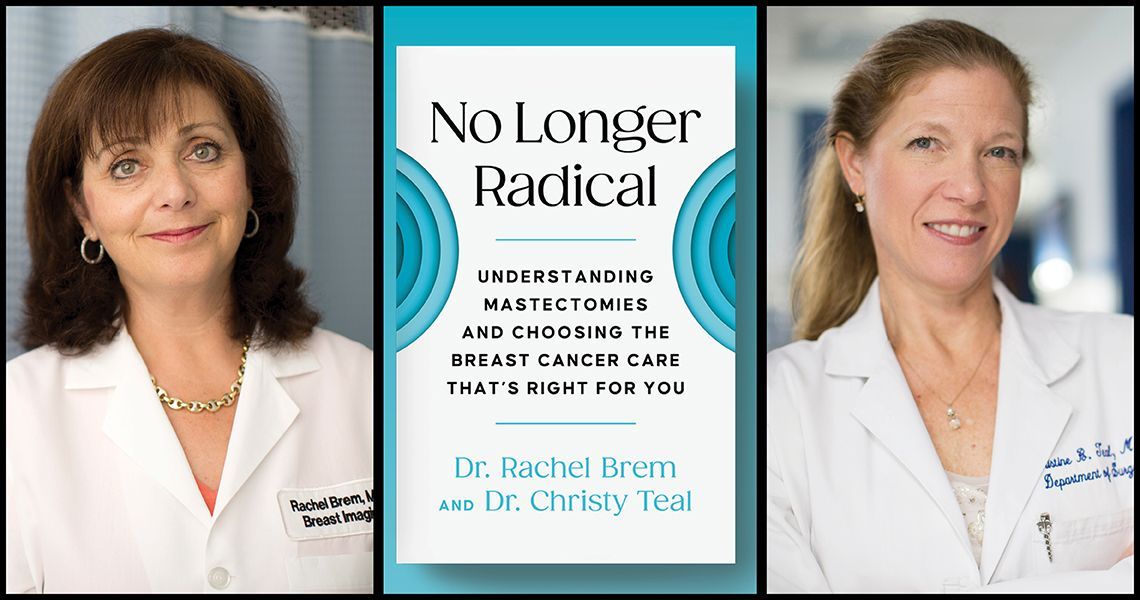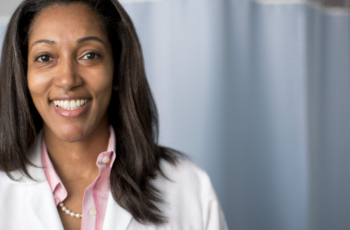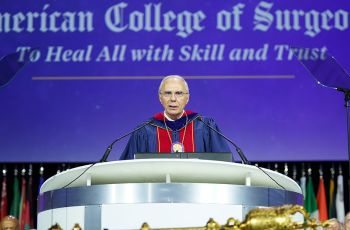October is Breast Cancer Awareness Month, and according to the National Breast Cancer Foundation, thanks to early detection and advanced treatment the five-year survival rate for patients is 99%. Recently, Rachel Brem, MD, vice chair of radiology and director of the George Washington University (GW) Medical Faculty Associates (MFA) Breast Imaging and Intervention Center, and Christine Teal, MD, associate professor of surgery and director of the Breast Care Center at the GW MFA, collaborated on a book about the breast cancer treatment experience, “No Longer Radical: Understanding Mastectomies and Choosing the Breast Cancer Care that’s Right for You.” Here they discuss their motivation for writing the book as well as the basics of breast cancer diagnosis and treatment.
Q: What made you decide to collaborate on this book?
Teal: I have always wanted to write a book with Rachel — we've known each other since 2001, when I joined GW and just a year after she started at GW — her story is really incredible. She was found to have BRCA1 mutation, a gene mutation which had only just been identified in 1994. [According to the Centers for Disease Control, “about 50 out of 100 women with a BRCA1 or BRCA2 gene mutation will get breast cancer by the time they turn 70 years old, compared to only 7 out of 100 women in the general United States population.”]
Brem: My mother had breast cancer when she was 33 years old and she had ovarian cancer at 46 with multiple recurrences. So in 1996, I decided to have prophylactic mastectomies. I really wanted to change the narrative of my life. I went around the country to find who I wanted to perform my surgery, and scheduled it. Then, weeks before my surgery, I was trying out some new ultrasound equipment and I found my own breast cancer. So, I missed my window of opportunity and I learned so much from that.
The reason I really wanted to work with Christy is not only that we’ve had the most extraordinary relationship, but also there are very few people who have a 360-degree view of breast cancer. We are the daughters of mothers with breast cancer. We were personally impacted by breast cancer. I had breast cancer. Christy, luckily, changed her narrative despite being at a very high risk for breast cancer. And, of course, we're experts in the field of breast cancer care and understand the medical part of it.
We decided that our perspective was so unique that we could give all women. Whether they had breast cancer, were at risk for breast cancer, or just by being a woman — which is the number one risk factor for developing breast cancer — the information we offer in the book is really practical, comprehensive, and compassionate information, and it empowers readers to make the best decisions for them rather than telling them what decisions to make.
It’s also important to note, there's nothing in medicine where a patient is asked to make so many decisions on their own. Are you going to have a lumpectomy or mastectomy? You’re told that the impact of chemotherapy decreases your disease by so many percent, should you have it or not have it? If you have strep throat, you’re prescribed an antibiotic and you take it. But with breast cancer, there are so many decisions and so many consequences that you are or are not told about. All of those things together made it obvious that we had to write this book together.
Q: What audience are you most eager to reach with this book?
Teal: Everyone's been touched by breast cancer, if you think about it. There’s even a chapter geared toward family members and how they can help their loved one as they go through their treatments. It’s an educational book. It’s a very well-rounded book in that sense, and pretty much anyone who’s been touched by breast cancer will gain from the book.
Brem: Our book has been described as comprehensive and factual, but with the emotional space people need in order to deal with breast cancer.
Every woman is at risk for breast cancer, so our audience is every woman and those that love them. There are questions at the end of each chapter to ask your doctor, whether it’s about screening, diagnosis, imaging, or surgical or reconstructive techniques.
Q: How have early detection, prevention, and treatment options for breast cancer changed over the years?
Brem: Oh, my goodness, so much has changed, and as a consequence of that, the death rate has been markedly decreased. Today, the death rate from breast cancer has dropped by 40% over the past decade. So nearly half of women diagnosed with breast cancer are spared a terrible outcome, the worst outcome. So that’s huge.
There are so many more treatment options, the reconstruction is just beautiful, and chemotherapy has become much more direct. When I was diagnosed, when I had chemotherapy therapy, every woman who had a one-centimeter breast cancer tumor or larger had chemotherapy. Now we use personalized and molecular medicine to determine who would benefit from chemotherapy and who wouldn't.
When we look to the future, we see liquid biopsies that will be able to diagnose breast cancer even without imaging, before it’s big enough to diagnose the way we diagnose it now. If someone does need a mastectomy, with tissue engineering we may be able to develop a scaffold and build a new breast from their own tissue.
Q: Although the 5-year survival rate for breast cancer is 99% when the disease is caught early, breast cancer was the second leading cause of cancer death among women in 2021. What do you think is behind those two opposing statistics?
Teal: We’re not there yet. There are so many things that have improved survival, early detection is number one, thanks to our amazing women imagers and radiologists, and more targeted therapy.
For patients with a HER2 positive cancer [a more aggressive type of cancer that tests positive for a protein called human epidermal growth factor receptor 2], before we had [the drug therapy] Herceptin, it was almost a death sentence. Now those patients, even if they have metastatic disease, can live for years because we’ve got so many targeted treatments.
There is a subset of patients, however, where we don’t find their cancers early, or we don’t have targeted treatment options, such as the triple-negative patients, where their estrogen, progesterone, and HER2 receptors are negative. We’re doing better with immunotherapy for those patients, but there are still a number of patients where they’re not diagnosed early or we run out of treatment options for them. And that’s why the death rate is still so high.
To make an appointment with a breast care specialist, visit the GW MFA Comprehensive Breast Center or call 202-741-3270.




